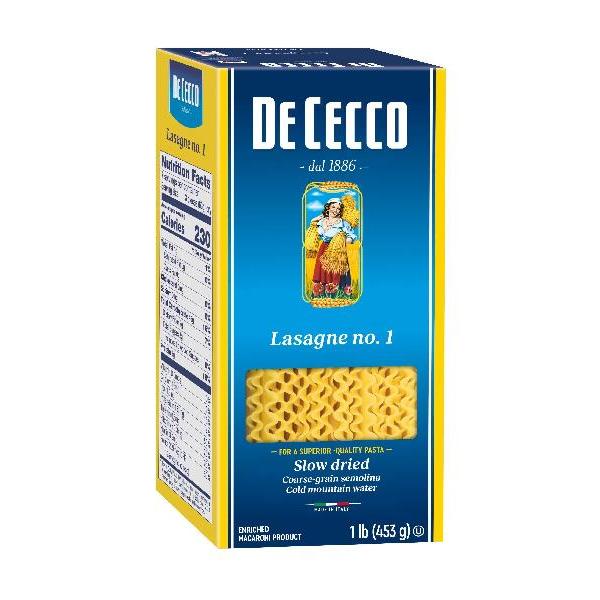Description
Pasta/Noodles ヨ Not Ready to Eat (Shelf Stable)
Lasagna is one of the oldest forms of pasta recorded. It probably corresponds to the Latin "Lagana" (which in turn was derived from the Greek "laganon": large, flat sheet of pasta cut into strips) and it began to be known as "Lasagna" probably after the year 1000 AD. The first traces of the widespread use of the term "Lasagna" can be found in the works of the most renowned 12th century Italian poets. "Granel di pepe vince / per virtu la lasagna", (a peppercorn beats lasagna for virtue) states Jacopone da Todi. Cecco Angiolieri,on the other hand, warns his readers, "chi de l'altrui farina fa lasagne / il su' castello non ha ne muro ne fosso" (He who makes lasagna with another's flour / his castle will have no walls or moat). It has long been one of the most well-known and popular types of pasta in Italian cooking, and the simplest and most commonly used recipe calls for a ragu, bechamel and parmesan, although mozzarella has also been introduced more recently. Delicious "white" versions
Ingredients: Durum Wheat Semolina, Vitamins (niacin, Thiamine Mononitrate, Riboflavin, Folic Acid), Iron (ferrous Lactate). Contains Wheat. May Contain Eggs And Soy.
Allergens: Not Available
Storage: STORE AWAY FROM HEAT, HUMIDITY AND DIRECT SUNLIGHT
Lasagna is one of the oldest forms of pasta recorded. It probably corresponds to the Latin "Lagana" (which in turn was derived from the Greek "laganon": large, flat sheet of pasta cut into strips) and it began to be known as "Lasagna" probably after the year 1000 AD. The first traces of the widespread use of the term "Lasagna" can be found in the works of the most renowned 12th century Italian poets. "Granel di pepe vince / per virtu la lasagna", (a peppercorn beats lasagna for virtue) states Jacopone da Todi. Cecco Angiolieri,on the other hand, warns his readers, "chi de l'altrui farina fa lasagne / il su' castello non ha ne muro ne fosso" (He who makes lasagna with another's flour / his castle will have no walls or moat). It has long been one of the most well-known and popular types of pasta in Italian cooking, and the simplest and most commonly used recipe calls for a ragu, bechamel and parmesan, although mozzarella has also been introduced more recently. Delicious "white" versions
Ingredients: Durum Wheat Semolina, Vitamins (niacin, Thiamine Mononitrate, Riboflavin, Folic Acid), Iron (ferrous Lactate). Contains Wheat. May Contain Eggs And Soy.
Allergens: Not Available
Storage: STORE AWAY FROM HEAT, HUMIDITY AND DIRECT SUNLIGHT
- SLOW DRYING We still use the same method today to best preserve the natural flavor and aroma of wheat and the natural color of our semolina for a superior quality pasta.
- COARSE-GRAIN SEMOLINA We use only モcoarseヤ-grain semolina flour in order to preserve the integrity of the gluten and obtain a pasta which is always モal denteヤ.
- COLD MAJELLA MOUNTAIN WATER We make our dough solely with cold water from the Majella mountains, at a temperature of less than 59ᄚ F ensuring perfect firmness when cooked.
- BRONZE-DRAWN TEXTURE We craft our pasta with bronze draw plates to guarantee the ideal porosity to best capture the sauce.

